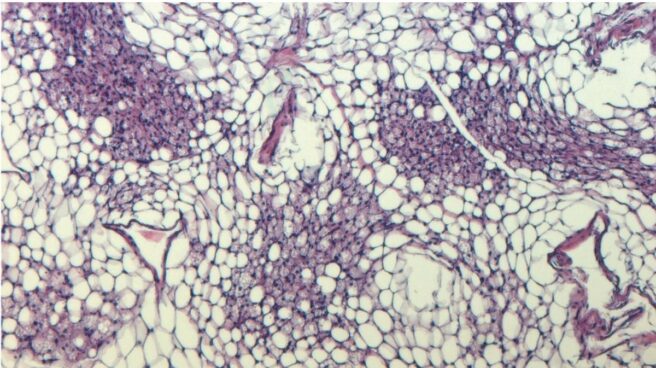

White adipose tissue with white and beige adipocytes (purple staining indicates beige cells) for controls and samples with a TLE3 deletion.
A study conducted by the University of Bonn and the Bonn University Hospital (Germany) has identified a molecule inosine purine, which enhances fat burning in brown adipocytes.
Mechanism published in a scientific journal Naturewas found in mice, but probably also exists in humans. If the inosine transporter is less active, mice remain significantly leaner. despite a fatty diet.
Normally, fat cells store energy. However, in brown fat cells, energy is dissipated in the form of heat, so brown fat serves as a biological heater. In this way, most mammals have this mechanism. In humans, it warms newborns; in adults, brown fat activation is positively correlated with cardiometabolic health.
“Today, however, we are well dressed even in winter. So our body’s own furnaces are hardly needed anymore. At the same time, we are eating more and more high-calorie foods, as well as we move much less than our ancestors. These three factors are poison to brown fat cells: little by little they stop working and eventually die. In addition, the number of severely overweight people worldwide continues to rise. For this reason, research groups around the world are looking for substances that stimulate brown fat and thereby increase fat burning,” says Alexander Pfeifer, one of those responsible for the work.
Together with a group of colleagues, a team from the University of Bonn identified a key molecule called inosine, which can burn fat. “Dying cells are known to release a mixture of messenger molecules that affect the functions of their neighbors. We wanted to know if this mechanism also exists in brown fat,” said Birte Niemann, another of the authors of the study.
In this way, The researchers studied brown fat cells under severe stress.so that the cells are almost dead. “We found that they release the purine inosine in large amounts,” says Niemann.
What was most interesting, however, was how intact brown fat cells responded to the molecular call for help: they were activated by inosine (or simply by dying cells in their environment). Thus, inosine kindled a fire in him. The white fat cells have also turned into their brown sisters. Mice fed a high-calorie diet and simultaneously treated with inosine remained leaner than control animals and were protected from diabetes.
The inosine transporter appears to play an important role in this context. This cell membrane protein transports inosine into the cell, thereby reducing the extracellular concentration. Consequently, inosine can no longer exert a combustion-stimulating effect.
“There is a drug that was actually developed to treat bleeding disorders, but it also inhibits the inosine transporter. We gave this drug to mice, and as a result, they burned more energy, ”says Pfeiffer.
Humans also have an inosine transporter. In two to four percent of people, it is less active due to genetic variation. “Our colleagues from the University of Leipzig performed a genetic analysis of 900 people. Subjects with a less active carrier were, on average, significantly thinner,” explains Pfeifer.
These results suggest that inosine also regulates thermogenesis in human brown fat cells. Thus, agents that interfere with transport activity may potentially be useful in the treatment of obesity. A drug already approved for bleeding disorders can serve as a starting point.
“However, further human studies are needed to elucidate the pharmacological potential of this mechanism,” says Pfeifer. He also does not believe that one pill alone will be the solution to the problem of the obesity pandemic raging in the world. “But the treatments currently available are not effective enough. Therefore, we urgently need drugs to normalize the energy balance in obese patients.”
Source: El Independiente